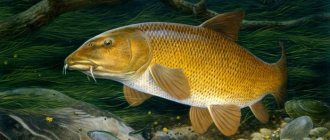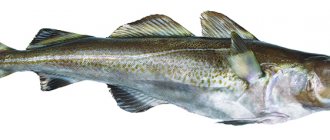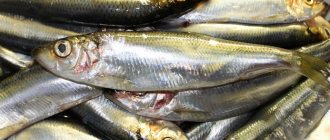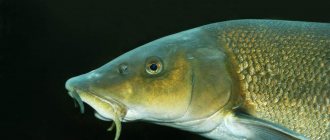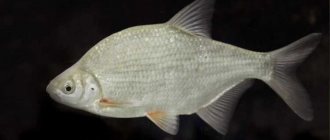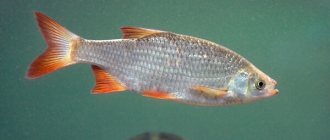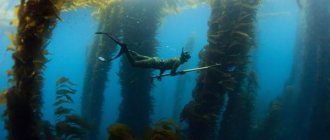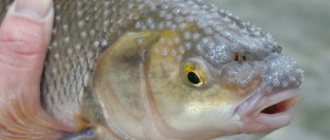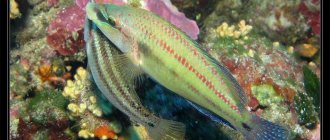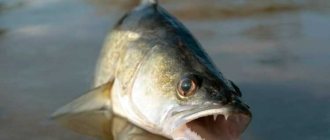Monkfish is a predatory fish species. Its distinguishing feature is its extremely unattractive appearance. There is a version that the fish received such a formidable name because of its appearance. There are fish at the bottom of the reservoir, hiding between rocks and in the sand. The anglerfish lives almost all over the globe.
Monkfish is a predatory fish with a terrible appearance.
general information
Monkfish belongs to the ray-finned fish of the anglerfish family . An adult fish grows up to 2 meters in length and weighs at least 20 kg. But most often you come across individuals up to 1 meter in size and weighing up to 10-12 kg. The sea devil has a flattened, disproportionate body and a very large head, which can occupy 2/3 of the body. Colored brown with a greenish or red tint. The abdominal cavity is white.
The mouth is large and wide with sharp and concave teeth. The skin has no scales. The eyes are quite small, seeing almost nothing, and the sense of smell is also very poorly developed. Around the anglerfish's mouth there are folds that periodically move, creating the appearance of algae.
The anglerfish has a disproportionately large head and reaches quite impressive sizes.
The front fin plays a special role in the life of a fish. It has six rays, half of which grow separately. One of them hangs forward and forms a fishing rod, thanks to which the fish received another name - the European anglerfish. The rod is equipped with a base, fishing line (the thin part) and a luminous bait.
https://youtube.com/watch?v=FWSq6DDGcrE
Description of appearance
The monkfish got its name due to its scary appearance. This creature looks disproportionate. The size of the head is much larger than the length of the body. The body itself looks like a ball. The huge mouth with sharp curved teeth is much larger in size than the entire head. This allows the predator to swallow its large prey.
The body is colored brown, gray or black. This fish, called monkfish, can camouflage itself for more successful hunting. With the help of this feature, a deep predator with a light on its body hides among the vegetation, waiting for its prey. The skin is smooth, there are no scales, and some species of lanternfish have tiny, sharp spines on the surface of the body.
The deep-sea fish that were caught in fishermen's nets had a bloated shape and bulging eyes. This appearance is due to an excess of internal pressure, which is present at a depth of 2 thousand meters, where the anglerfish lives.
The creature, which is called a sea devil, does not swim, but pushes off the bottom with its fins, and then jumps. Another amazing feature of the scary aquatic creature that lives in the depths of the ocean is the difference between females and males. Females grow about two meters long from head to tail. The average body weight is 45 kilograms. The visual apparatus and sense of smell of the terrible fish are poorly developed. Males are no more than 4 centimeters in size, but they have very developed vision and sense of smell, which help them search for females.
Yandex pictures
Habitats
Monkfish lives in many seas and oceans. The European anglerfish is widespread in the Atlantic Ocean. Here it lives at a depth of 20 meters or more . It is also caught along the coast of European water bodies, in the Barents and North Seas.
Monkfish mainly lives in the Atlantic Ocean, at a depth of 20 meters.
Far Eastern fish species are often found near Japan and Korea. They live in the South China, Yellow and Okhotsk seas. The comfortable depth for them is 40-200 meters.
Hatched young fish differ from adult fish. At first, the fry feed on plankton, live in the upper layers of the reservoir, and when they reach a length of 10 cm, they change appearance. Then they move closer to the bottom and begin to lead a predatory lifestyle. In the first year after birth they grow very quickly.
Not long ago, related species of anglerfish were discovered. They began to be called deep-sea anglers. Individuals can withstand very high water pressure and are found at a depth of about 2 km.
https://youtube.com/watch?v=FWSq6DDGcrE
Reproduction of anglerfish
Representatives of this species are distinguished by special reproduction. Females and males are very different from each other and ichthyologists have long considered them to be different fish. When the male reaches the age of sexual maturity, he goes in search of a life partner. A large olfactory organ and huge eyes help him in this.
Ichthyologists do not know how long the search takes. Once a female is discovered, the male latches onto her with his jaws. His tongue and lips completely grow into the bride's body. She takes him into complete dependence and supplies him with nutrients through ingrown vessels. The male's intestines, jaws and eyes atrophy. The gills and heart work in his body - they supply the body with oxygen.
Female and male anglerfish have long been considered representatives of different species
During spawning, the female lays eggs, and the male inseminates her with milk. This happens in winter and spring. The caviar comes out in the form of a strip. Its length can reach 9 meters. Young fish switch to a bottom lifestyle when their body length is 6 cm. Before this, they live in the upper layer of water and feed on small crustaceans and fry. It is noteworthy that females can carry up to four males at a time .
Diet
In terms of their feeding habits, sea devils are predators. Their main diet consists of bottom fish. First of all, what gets into the devil’s stomach is:
- gerbils;
- cod;
- small slopes;
- flounder;
- acne;
- squid;
- various crustaceans.
Sometimes predators swim to the upper layers of water, where they hunt mackerel and herring.
All individuals hunt from ambush . Due to their appearance, they are difficult to notice among stones and algae. Potential prey is attracted by the luminous bait. When a fish, crustacean or other underwater creature touches the rod, the monkfish suddenly opens its mouth, resulting in a vacuum. After this, the victim, along with a stream of water, ends up in the mouth.
The anglerfish hunts from ambush, luring prey onto a luminous fishing rod.
Monkfish may not move for a long time, waiting for prey. In addition, the fish is able to hold its breath, with pauses between breaths lasting about 2 minutes.
People have long believed that fish open their mouth only when prey approaches. However, scientists have proven that the mouth comes off automatically when any object floats past.
The European anglerfish is very greedy and gluttonous. Sometimes this leads to the death of the individual. Having huge mouths and stomach, the fish can swallow large prey.
Large and sharp teeth simply do not allow the predator to let go of the prey; as a result, it chokes and dies. There have been cases when fishermen found a victim in the stomach of a caught anglerfish that was only 7-10 cm smaller than the monkfish itself.
Lion fish
The colorful lionfish (striped lionfish), about 30 cm long, spends most of its time in coral reefs, frozen in a motionless state, waiting for prey. Its amazing appearance is given by its long needle-like fins, which frame the body like a fan and contain poisonous glands.
Marine inhabitants perceive the motley color of the lion fish as a warning signal to trigger the instinct of self-preservation, while in people, on the contrary, everything bright causes increased interest, which sometimes leads to sad consequences.
The striped lionfish lives off the coasts of the Indian and Pacific oceans, and is sometimes found in the waters of the Caribbean. She never attacks first, but if you accidentally touch her or try to touch her out of curiosity, then unpleasant sensations and deterioration in well-being are guaranteed. As a rule, the poison is not fatal, but in the case of several fin pricks, unbearable pain can occur, including loss of consciousness, so a person may need outside help to get to the shore.
Types of anglerfish
The anglerfish became known in the middle of the 18th century. To date, 7 species of this inhabitant of aquatic fauna are known:
- European marine species or linophrine (found in 1758).
- Southern European anglerfish (1807).
- American Monkfish (1837).
- Cape monkfish (1837).
- Japanese anglerfish (1902).
- South African anglerfish (1903).
- Western Atlantic view (1915).
There are several varieties of monkfish, differing in their habitat.
The American bottom dweller is a predatory fish and has a body length from 0.8 to 1.3 m with a weight of up to 23 kg. The huge head makes the fish look like a tadpole. The lower jaw is wide and drooping. Interestingly, even with the mouth closed, huge sharp teeth are visible, which are arranged in three rows. The fish lives up to 30 years. It lives along the Atlantic coast at depths of up to 650 meters. The predator feels comfortable at temperatures from 0 to 23 °C.
The European predator grows up to 2 m in length and weighs over 20 kg. The body is flattened, disproportionate. The head can occupy 75% of the total length of the fish. The body has no scales, but there are all sorts of skin growths and bone spines. Gill slits are located just behind the wide pectoral fins, which allow individuals to move and burrow into the ground. Its habitat is the Atlantic Ocean, washing the shores of European countries, the waters of the Baltic, Barents and even the Black Seas.
The length of some species varies from 0.8 to 2 meters.
Far Eastern fish is a typical representative of the Japanese, Yellow and East China Seas. The preferred habitat depth is from 50 m to 2 km. Predators of this species grow up to one and a half meters. Like all types of anglerfish, the Far Eastern species has a flattened body. The only difference is the length of the tail - the Japanese one is longer. Sharp and concave teeth are arranged in two rows. The body has a uniform brown tint.
general characteristics
There is another name for a fish with a flashlight on its head - it is an anglerfish . This is a predator that belongs to the order of anglerfish and the class of bony fish. Lives at the bottom of the sea. It reaches two meters in length. Average weight - 20 kg. Large individuals weighing 57 kg are also known.
The body is flattened, compressed in the abdominal direction. The mouth is several times larger than the head.
A distinctive feature of the monkfish is its slightly protruding lower jaw. She is inactive. The mouth is decorated with sharp teeth that are slightly curved inward. The jaws have flexible and thin bones that allow the anglerfish to swallow large fish. There are small eyes at the top of the head.
A separate process grows from the dorsal fin. It is shifted to the upper jaw and represents a fishing rod. There is a leathery formation on it - it serves as bait and is a bag of mucus in which luminous bacteria live. The angler can turn off the light for a while so as not to attract the attention of large predators.
The habitat of deep sea flashlight fish is varied. It can be found in countries such as:
Some representatives of the species are found in the waters of the Black and Yellow Seas. It can live at different depths.
Reproduction of adult fish
To spawn, adult individuals descend to a depth of 400 meters and below. The whole procedure takes place at the end of winter - beginning of summer . In the northern regions this period shifts to mid-spring. Descending to depth, females begin to lay eggs, while males cover them with milk. After the procedure, individuals float closer to shallow water, where they feed until late autumn.
The laid eggs form a ribbon that is covered with mucus. On average, the width of the eggs reaches 50-90 mm, the thickness - 40-60 cm. Some time after deposition, the walls of the cells are destroyed, and the eggs begin to move freely in the water column. After a few days, the larvae hatch from there.
Stone fish
A small sea creature 15-20 cm long with small eyes against the backdrop of a disproportionately large head and mouth, it is deadly to humans. You can meet it in the Red Sea, and in shallow areas of the Pacific and Indian oceans.
The amazing appearance with numerous warts and bumps on a brownish-brown body has given the stonefish other names: wart or tuberculate. The danger comes from the spines with poisonous glands on the back, which make the wart the most poisonous representative of the fish world.
The spikes immediately dig into a person upon accidental contact, and the released poison affects the central nervous system and causes the destruction of red blood cells. There are cases where death occurred within a few hours and even minutes after a wart injection. And those people who are lucky enough to survive after it often become disabled.
Where does monkfish live?
Photo: Monkfish in the water
Anglerfish can be found in the following habitats:
- Atlantic Ocean;
- European coast;
- Iceland;
- Barencevo sea;
- Gulf of Guinea;
- Black Sea;
- North Sea;
- English Channel;
- Baltic Sea.
Depending on the species, they can live at a depth of either 18 m or 5 thousand meters. The largest species of anglerfish (European) prefer to settle near the ocean floor, where the sun's rays do not reach.
There, the anglerfish becomes the only source of light on which small fish bite. Anglerfish lead a sedentary lifestyle and mostly lie on the bottom, trying to be as inconspicuous as possible. They don’t build any shelters, they don’t choose a permanent habitat.
Anglerfish don't like to swim. Some subspecies of monkfish have dense lateral fins that rest on the bottom when the fish lies down. Scientists believe that with the help of these fins the fish seems to “walk” along the bottom, pushing itself with movements of its tail.
The lifestyle of anglers is based on the fact that with little prey and high pressure, they need to maintain a stable body weight in order to comfortably exist in such an unfriendly environment. Therefore, sea devils are focused on maximizing energy conservation, so they settle in places where they need to move less and, especially, hide less from predators and other dangers.
Now you know where monkfish live. Let's see what he eats.
Natural enemies of monkfish
Photo: Monkfish fish
Due to its gluttony and low intelligence, the monkfish often attacks prey that it is unable to handle. But in general, it is not of interest to marine predators, therefore it is more of an accidental prey than a targeted object of hunting.
Most often, monkfish are attacked by:
- squid. Anglerfish have sometimes been found in the stomachs of colossal squid;
- large octopuses;
- large dragon fish;
- a bagmouth can easily swallow even a large anglerfish;
- giant isopods eat baby monkfish;
- goblin shark;
- a mollusk called "hell vampire".
Typically, the monkfish population suffers losses in the state of eggs or tadpoles. Tadpoles that live near the surface are eaten by whales and plankton-eating fish.
In general, sea devils do not have natural enemies for a number of reasons:
- he is perfectly camouflaged;
- have no nutritional value for many fish and marine life;
- live too deeply;
- They themselves are at the top of the food chain in their natural habitat - at the bottom.
